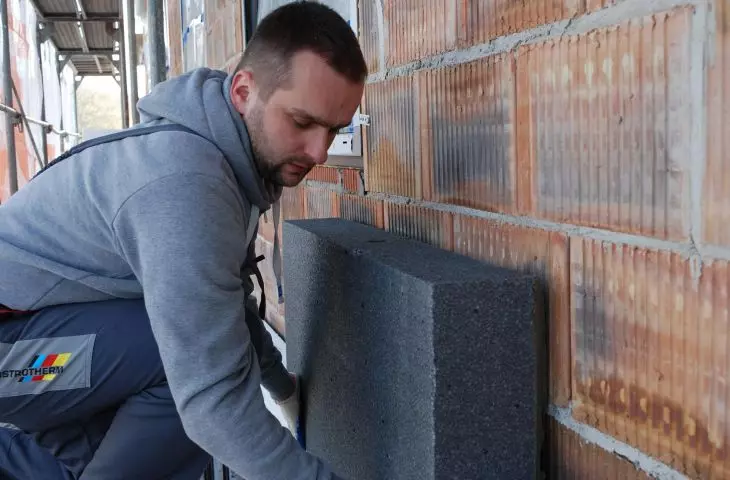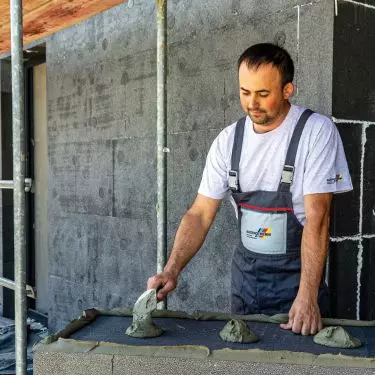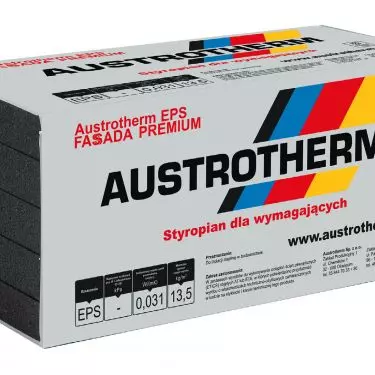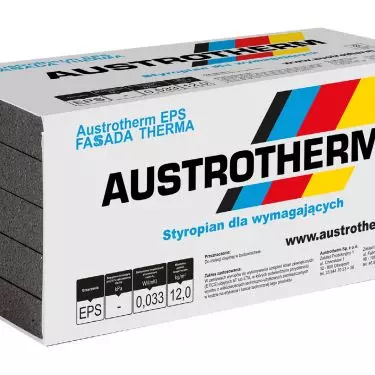What to pay attention to when choosing Styrofoam?
Pay attention to the manufacturer's declared lambda (λD), or thermal conductivity coefficient. It depends on the density of the polystyrene foam. The more "polystyrene in polystyrene", the higher the weight per m3 and the more you will get from the insulation.
Remember that the higher the density of Styrofoam, the lower and better the lambda. The lower the lambda, the better the Styrofoam, and thus the possibility of using less thickness. It also means additional savings by using less mesh, glue and plaster.
Do not choose Styrofoam with a density lower than 11 kg/m3. Below this density, Styrofoam does not meet the required strength parameters - TR (tensile strength) and BS (bending strength), especially important when insulating the exterior walls of buildings.
Take into account that the weaker the strength parameters, the greater the risk of the facade's lack of durability and the need for premature disposal or dismantling. This brings with it the cost of getting rid of the waste, making new insulation from scratch and reducing the expected period of savings on heating expenses.
Energy prices continue to rise. An uninsulated roof, walls and basement cause uncontrolled heat loss, which can be eliminated by up to 70%. Therefore, remember that Styrofoam panels account for only about 15% of the cost of insulation, so choose consciously so that your expenditure brings you maximum savings.
A gray polystyrene board has a significantly better, i.e. lower, thermal conductivity value λ than a standard white polystyrene board
© AUSTROTHERM
Is gray Styrofoam warmer than white Styrofoam?
A gray polystyrene slab has a significantly better (i.e. lower) lambda thermal conductivity value than a standard white polystyrene slab. Comparing this parameter with the thickness of the board, we get the so-called warm resistance of the insulation layer, which is closest to the term "warmer." Translating this into construction reality, comparing a gray slab with λD≤0.031 W/mK with a white polystyrene slab with λD≤0.045 W/mK of the same thickness, the one that is "warmer", i.e. with a significantly higher thermal resistance, will be the gray slab. The difference in thermal insulation of these boards can be more than 30%. In the above comparison, with a difference in the thickness of thermal insulation, often reaching up to 8 cm, the use of gray boards will allow, among other things, to reduce the cost of heating the building.
Where is it best to use gray polystyrene foam?
Wherever we care about the best thermal insulation parameters of the partition with the lowest possible thickness. The ever-increasing requirements for the energy efficiency of buildings and the thermal insulation of the building envelope have resulted in a huge increase in interest in gray Styrofoam panels. This is due to the fact that these products - compared to white EPS panels - allow to reduce the thickness of the thermal insulation layer by up to 30%. It should also be mentioned that gray polystyrene boards are characterized by a very good ratio of price to the declared thermal conductivity coefficient. They are most often used for thermal insulation of floors on the ground, solid and ventilated ceilings, terraces and balconies, attic ceilings and external walls in the ETICS system.
Insulating a house helps reduce the cost of consumed energy, and, what is also important, maintains cozy warmth inside the house
© AUSTROTHERM
Installation of Austrotherm polystyrene boards
Styrofoam panels should not be exposed to the weather for longer than seven days. A starter strip should first be attached to the wall to maintain the horizontal line of the facade.
The adhesive mass should be applied to the Styrofoam panels using the so-called strip-and-point method, so that its total contact area, when pressed against the wall, is no less than 40% of the panel area. The width of the adhesive mass band along the perimeter of the board should be at least 3 cm. On the remaining surface, the mass should be spread in the so-called patches with a diameter of 8-12 cm.
After applying the adhesive mortar, the board should be immediately applied to the wall in the place provided for it and pressed until it is flush with the adjacent boards. Adhesive mass squeezed out beyond the outline of the panels, should be removed.
If the board is not properly glued, it should be detached, cleaned of the adhesive mass, reapply the adhesive to the board and repeat the fixing operation. On prefabricated walls, the panels should be glued so that the joints between them do not coincide with the joints of the walls. The joints between the panels must also not run in the corners of openings (windows, doors, etc.).
In the case of additional mechanical fastening of polystyrene panels, the number of fasteners, their location, taking into account the height of the building, edge zones should be determined by the design documentation.
If there is a need, it is recommended to use at least 4 fasteners per 1 m2. When selecting the length of the fastener, it is necessary to remember the correct depth of anchorage. Incorrect placement of anchor fasteners by excessive sinking of the plate into the polystyrene foam leads to rupture of its structure and weakening of the load-bearing capacity of the fastener.
For more information, visit the company's Austrotherm Sp. z o.o. page on thePdD portal.



































